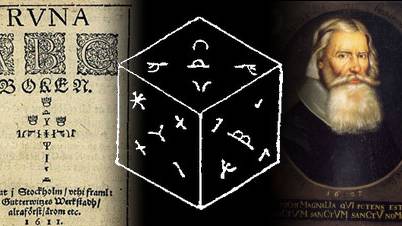Johannes Bureus, the Renaissance rune magician
Source: monas.nl
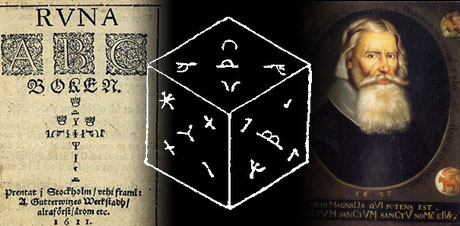
The National Library of Sweden has scans of Johannes Bureus Runa ABC boken
Ed comment: Everyone who is interested in people like John Dee and Francis Bacon should read more about Johannes Bureus, he is like a mix between the two. He was an advisor to King Gustav Adolf and just like Bacon, Bureus allegedly was involved in developing the Swedish language, like Bacon was involved in development of the English language.
When I read about Johannes Thomae Agrivillensis Bureus (latinisation of Johan Bure, 1568-1652), for the first time I realised that in Northern Europe during the Renaissance there actually hàs been a mix between pre-Christian religion/mythology and typical Renaissance magic (such as Hermetic, Kabbalah, Medieval magic, etc.). I started to look for information about this interesting character and his ideas and took up the idea to find out if there were more people in which these two interesting elements came together. I noticed that not only information about Bureus is quite scarse, but that the subject as a whole is very underlighted. The writer of the article The First Northern Renaissance (in the second volume of the Tyr magazine*) Stephen Edred Flowers has released on his own Rûna Raven Press a small booklet about Bureus' most famous work Adalruna Rediviva (first version 1605), which I of course got*. It is reviewed in the book reviews section. Other information is in Swedish, but I noticed that Bureus was spoken about at length in the book Rose Cross Over The Baltic by the Swedish investigator (who fortunately writes in English) Susana åkerman (Brill 1998, also reviewed*). Looking further it proved hard to find information about other people interested in Nordic mythology and Renaissance magic, but I kept running into åkerman. Since the works of Flowers and åkerman appear to be the only descent information about the Swede Bureus in English, but both are hard to get (a small publisher and a scholarly and very expensive publishing for universities) and there is also no proper information on the internet, I decided to write an article about Bureus as first introduction. This article may be regarded as advertisement for the book(let)s of Flowers and åkerman since it is mainly built on the information that they found. If this article catches your interest, I suggest you contact mr. Flowers to order his small but highly informative booklet. The work of åkerman you will probably have to get through a library. This book is available, but very expensive, like most of the Brill publishings. More information on the bottom of this article.
Investigating Bureus
Flowers claims that he first wrote about Bureus in 1986. The first thing I saw of him was the article in Tyr (2004) and later I got his booklet Johannes Bureus and Adalruna of 1998. Of the same year is åkerman's Rose Cross Over The Baltic, but this was not the first publication in which she speaks about Bureus. In the 1994 collection of articles under the title The Expulsion Of The Jews, 1492 and after (1994 Garlang publishing*) åkerman has an article called The Gothic Kabbalah: Johannes Bureus, Runic Theosophy and Northern Apocalypticism. Four years later follows her book and in 2001 åkerman has an article in the book Rosenkreuz Als Europäisches Phänomen im 17. Jahrhundert edited by Carlos Gilly (2001 In de Pelikaan*).
åkerman is mostly interested in the early Rosicrucian movement in Scandinavia, but she gives valuable information for my own investigation. åkerman names more famous and less famous Scandinavian Rosicrucians who sometimes got other interests as well. You can read about this in short in my previous article The Northern Tradition in the Renaissance. The article you are reading now will focus on Johannes Bureus. Helpfull to both åkerman and Flowers were Bureus diaries which were published in 1885 by the Royal library of Sweden in Stockholm.
Bureus
Bureus was born in 1568 in åkerby near the famous city of Uppsala (where the largest and last of the pagan temples has been) in Sweden as a son of a Lutheran parish priest. He had a good education in Uppsala, Stockholm and later he studied in Germany and Italy. In 1595 he studies theology, in 1602 he is professor and from 1603 on Royal antiquarian. Bureus died a cripple in 1652.
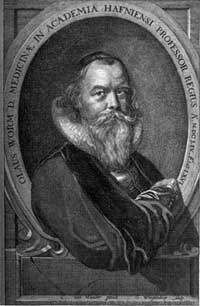 Ole Worm. More from: wikipedia |
Bureus and the runes
In 1593 Bureus became civil servant since he was appointed as editor of religious texts in Stockholm. Just before he moved there, Bureus ran into a runestone that awakened his curiosity. He lived in an area that has many runestones, but he never really noticed them before he saw the stone in front of the Cistercian cloister of Riddarholm. He was captivated by the strange scripts and wanted to learn how to read them. Therefor he travelled to the "culturally conservative" (a nice expression of Flowers) province of Dalarne and learned to read the runes from the local farmers. In 1599 and 1600 Bureus made an extensive trip through his native country to find more runestones so he could write down, translate and interpret the texts. King Karl IX even assigned him to translate certain stones. Like I said in my previous article, people became interested in their own past. The runestones could be helpfull and later ancient texts were bought from Iceland.
Bureus was (one of) the first persons to scientifically study the language of the runes. He even wrote a small booklet called Runa: ABC-boken (1611) to allow other people to understand the language. In this booklet Bureus gives his own set of runes, but also -for example- the Lord's Prayer in runes. This booklet can be found online on the site of the Royal Libary of Sweden (here).
After his trip and notes of all the runestones he could find, Bureus wrote several books about the runes, including one with information about the different stones he ran into (Monumenta Sveogothica Hactentus Exculpta, 1624). Obviously many got lost since...
Bureus was not the only one in his time studying in runes, because his Danish contemporary Ole Worm took up the same work in his own country. The two had many things incommon and knew eachother. On the origin of the runes the men didn't agree and there was a fierce series of publications in which the two attack eachother.
As for Northern mythology, Flowers suggests that Bureus and Worm may have know Grammaticus (as I wrote in my other article Tycho Brahe definately had a copy) and also may have possessed or at least seen copies of the Eddas. Both were in a good position for that, since both have been royal antiquarians.
The original language
 The Runa: ABC-boken already shows a bit of Bureus esoteric runology. As you can see in the image, Bureus has one rune less than the younger Danish futhark. Bureus wanted/needed to come to the magical number of 15 runes, in order to be able to make three divisions of five runes. Also Bureus exchanged the "Lagher" and "Man" runes. Also he said that the 'upsidedown' man-rune is the same as the "Rodhur" rune, so he could leave it away.
The Runa: ABC-boken already shows a bit of Bureus esoteric runology. As you can see in the image, Bureus has one rune less than the younger Danish futhark. Bureus wanted/needed to come to the magical number of 15 runes, in order to be able to make three divisions of five runes. Also Bureus exchanged the "Lagher" and "Man" runes. Also he said that the 'upsidedown' man-rune is the same as the "Rodhur" rune, so he could leave it away.According to Flowers the first group of five runes referred to the progenitor, the second to the generation and the last to the generated, thus God, creator, creation, quite a Hermetic idea. Bureus called his runes "Adalrunor" or "noble runes". Every rune has a specific meaning, just like with the other futharks that we know
 Bureus' runes don't always really look like the originals. His row looks mostly like the younger Danish futhark. According to Karlsson Bureus used the so-called "Hälsinge" runes to form his own futhark. The Hälsinge runes are 'staveless' runes. They seem to be a simplification of the younger (Danish) futhark. The image on the left shows the Hälsinge futhark. The black lines are the actual runes, the grey parts are used to show what comparable rune of the younger Danish furthark corresponds with the Hälsinge rune. Bureus must have had seen different kinds of runes and have known that there are more futharks, but you can imagine that with so simple runes, he could easily 're-invent' the complete runes according to his own wish.
Bureus' runes don't always really look like the originals. His row looks mostly like the younger Danish futhark. According to Karlsson Bureus used the so-called "Hälsinge" runes to form his own futhark. The Hälsinge runes are 'staveless' runes. They seem to be a simplification of the younger (Danish) futhark. The image on the left shows the Hälsinge futhark. The black lines are the actual runes, the grey parts are used to show what comparable rune of the younger Danish furthark corresponds with the Hälsinge rune. Bureus must have had seen different kinds of runes and have known that there are more futharks, but you can imagine that with so simple runes, he could easily 're-invent' the complete runes according to his own wish.I already mentioned a few 'colleagues' of Bureus. Especially Postel was obsessed by the search for the original (or perfect) language. Several people were of the opinion that the entire world had one language before the confusion at the tower of Babel. Then everybody got a different language so nobody could understand the other. For many Renaissance people the original language was the language of the Old Testament (and the Kabbalah): Hebrew. Postel wrote a book how the entire Hebrew script came from the single (and smallest) letter Yod. Also common was the idea that Japhet, a son of Noah, was the last man to possess the original language, so often you will read about the Japhetian language or the sons of Japheth (descendents or the race or the initiated, whatever they meant who still possess the original language). Another thing is that the original language came from the original land. These two things where not necessarily connected, but often they were. In the case of Bureus, this original land was Plato's Atlantis and this land was his beloved Scandinavia. Not only Bureus had this idea though, just think about 'Ultima Thule' which is also supposed to be in the far North. But to come back to the original language, Bureus had filtered out the original rune alphabet (however he addopted this in his own system) which Flowers calls "The Swedish ordering", but Bureus rune-row reminds me more of the younger Danish futhark as we saw.
Let me quote åkerman about all this:
"Scandinavia was the land of the Hyperboreans who had migrated to the Baltic shores before the fall of the Tower of Babel and who thereafter possessed the original, uncorrupted culture and spirituality of mankind. The name Scandinavia itself had dirived from Noah's son and grandson Japheth and Ashkenaz (giving them the name Skanzea)" (Expulsion p. 177/8).
("Baltic" are the lands around the Baltic sea, by the way, usually the Scandinavian countries are meant.) She writes almost the same in Rose Cross (p. 28):
"Adressing himself to the Rosicrucians, Johannes Bureus proclaimed in his FaMa e sCazIa reDUX (1616) that the north was distinct in culture and knowledge, that much of this Hyperborean tradition was preserved in the Gothic-Scandinavian Runes, and that a northern wisdom existed that could ensure salvation to those who sought it."
Bureus wrote more than one reaction to the Rosicrucian manifestoes, åkerman refers to one of them in this last quote.
Primeval Northern land
åkerman again:
"Bureus in 1612 began to focus on Zamolxes, the Gothic legislator, who as a northern philosopher in 530 B.C. had brought a magical potion, the "pharmakon", to Italy. In his ethnographic studies, Bureus then sought to clarify precisely the knowledge with which Abaris, the northern Thracian sage, had influenced Pythagoras." (Rose Cross p. 31).Bureus shared these ideas with the Rosicrucians, but however they too were looking for Hyperborean knowledge, they did not agree with Bureus. Also the Confessio Fraternitates (the second Rosicrucian manifesto) speaks about the Rosicrucian (i.e. original) language, but Bureus' claims that this is the runic language was not an idea that was received with open arms.
But, Bureus also had ideas that were shared with others, or in this case it may be better to say that he took it over from someone else. Bureus had extensively studied Postel and he took over many of Postel's ideas, but changed them according to his own ideas. An idea of Postel was that ancient Sibyls gave the original Knowledge to people like Pythagoras.
"Yohannes Bureus, the Swedish antiquarian and teacher of Gustav Adolf, worked as a royal archivist and found much inspiration in the French visionary Guillaume Postel's cosmographic ideas on the northern spread of the Hyperborean peoples. He was particularly interested in Postel's claims concerning the double sources of prophecy: that the Old Testament prophets are completed by the Sibylline oracles, and of the prophetic role of Alruna, the northern Sybil, who like the Celtic druids had been revered for her great visionary powers. Alruna was born in 432 BC and Bureus believed she knew the great Thracian Sibyls, Latona, Amalthea, and Acheia." (quote).And so we come to the next paragraph.
Esoteric runes
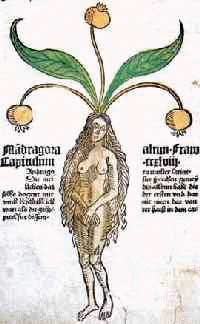 We just saw that "Alruna" was an ancient Northern woman of knowledge. "Alruna" is also the Swedish word for "Alraune", "Alruin" or "Mandragora", the most famous of magical plants and often depicted in alchemical drawings as a crossbreed of a man and a plant. Bureus had another use of the word though.
We just saw that "Alruna" was an ancient Northern woman of knowledge. "Alruna" is also the Swedish word for "Alraune", "Alruin" or "Mandragora", the most famous of magical plants and often depicted in alchemical drawings as a crossbreed of a man and a plant. Bureus had another use of the word though.As we saw, Bureus divided his runes in three groups of five. Three is a significant number in his system, just as it was in the ancient Northern culture. Bureus also said that there were three levels of the interpretation of runes:
1 Runic, the "literal level is chiseled into the stones. Taken literally, Runic texts make typical reference to sacred microcosmis events, such as the claiming of land or the remembrance of the dead."
2 Adulrunic (Flowers writes Adalrune), "is entirely interpretative. According to Bureus, it conveys the glory of macrocosmic structures, such as the majesty and kingship described in his Gothic manual Adulruna Rediviva."
3 Alrunic, "is thought to represent the divine aspects of nature in a more general way. Bureus describes it as "catholic", to be used to interpret the available stock of myths and prophecies universally, i.e., for all times and peoples, but from the perspective of the Hyperboreans." (Rose Cross p. 57).
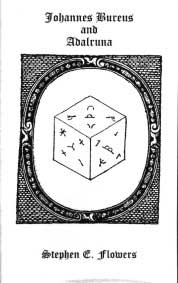 It is strange to see how Bureus may have studied the mythology of his own ancestors, but how heavily he was influenced by foreign interpretations of these myths. Following the comparison of Northern and Greek mythology Bureus said that
It is strange to see how Bureus may have studied the mythology of his own ancestors, but how heavily he was influenced by foreign interpretations of these myths. Following the comparison of Northern and Greek mythology Bureus said that"Thor was God the Father, or Lumen, the Themis lex divina and the Thora lex judeorum, and even Jupiter Mandragora. Othin was the Son, or the Verbum Dei, the sapientia of the Pythagoreans, Mars, and Hercules, Freya was identical with the Holy Spirit, or the foecunditas universi, the bonitas divina, the Diana of the Ephesians." (Rose Cross p. 34).
To these three gods, Bureus linked three of his runes. The "Thors" (rune alphabet above) "is equated with the Norse god Thor. This force is actually andronygous. Bure points to an image of Thor found in Uppsala which is masculine in the upper body, feminine below. [...] Thor is linked with Jove [Jupiter] and hence to Jehovah" (Flowers p.13). This rune is the middle figure of the upper face of the cube on the cover of Flowers' booklet. It has been turned 90 degrees to the left. The same Bureus does with the two runes on the left and the right. The left rune is for Odin and the right rune Freya. Above and below are the rune R and U and U and R.
In the same manner Bureus has two more figures (the other visible faces of the cube) which Flowers explains at length in his booklet. This shifting around with letters, appointing numerological values to them, making words, changing words and sentences is quite like the Kabbalah method of Notaricon and the figure on the bottom left face of the cube even is called NotAriKon. Also Bureus keeps refering to the Bible.
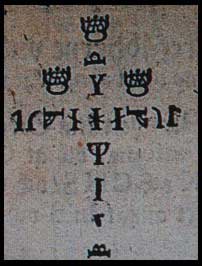 In this manner Bureus works towards his ultimate masterpiece, which can also be found in his ABC-boken, the runic cross. This figure has an extremely layered explanation. You can see Christ hanging on the cross (do you see his head ("Thors" rune), arms (the Odin and Freya runes of above), etc.?). The seven runes forming Christ are linked to the days and planets. Also you can follow the lines of the runes and this form some kind of hieroglypic figure, a little bit like an upside-down Monas Hieroglyphica (with some imagination) and indeed, Bureus wàs heavily influenced by this short text and the symbol of John Dee (1527-1608). Bureus' runecross is equally complex and hard-to-explain and
In this manner Bureus works towards his ultimate masterpiece, which can also be found in his ABC-boken, the runic cross. This figure has an extremely layered explanation. You can see Christ hanging on the cross (do you see his head ("Thors" rune), arms (the Odin and Freya runes of above), etc.?). The seven runes forming Christ are linked to the days and planets. Also you can follow the lines of the runes and this form some kind of hieroglypic figure, a little bit like an upside-down Monas Hieroglyphica (with some imagination) and indeed, Bureus wàs heavily influenced by this short text and the symbol of John Dee (1527-1608). Bureus' runecross is equally complex and hard-to-explain and  John Dee's Monas Hieroglyphica |
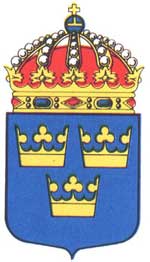 Three Crowns of Sweden. More from wikipedia |
The secret calculation of time
Flowers closes off his booklet with a chapter about the secret calculation of time. Like I said, like in Kabbalistic systems, each letter had a numerological value and Bureus had the habbit of playing with this in order to refer to years in which something great (apocalyptic) would happen. He did this with his runic system, but also in his Latin texts. You may have noticed the strange capitals in the title of the Rosicrucian text that I mentioned? Well, the capitals are Roman numerals. åkerman also spends a few pages to this strange element in Bureus' writings.
Conclusion
This short article really cuts the man short. I hardly said anything about the man's Rosicrucian efforts and his ideas are merely touched upon. Also there is a large field of investigation left, but this will have to be done by someone who has access to and can read Bureus' works. Most of it is stuffed away in Swedish libraries. Some investigations have been done, but they are mostly written in Swedish. In English I have only been able to find åkerman and Flowers and a few separate remarks here and there. But, should you want to learn more about Bureus and his ideas, the writings of åkerman and Flowers are a very good start. I hope more investigation will follow.
Short Bibliography
The Gothic Kabbalah: Johannes Bureus, Runic Theosophy and Northern Apocalypticism by Susanna åkerman in The Expulsion Of The Jews - 1492 and after edited by Raymond B. Waddington and Arthur H. Williamson, 1994 Garland publishing, ISBN 081531681X.
Rose Cross Over The Baltic by Susanna åkerman, 1998 Brill, ISBN 900411035.
Johannes Bureus and Adalruna by Stephen Edred Flowers, 1998 Rûna Raven Press
Rosenkreuz als europäisches Phänomen im 17. Jahrhundert edited by Carlos Gilly, 2001 In de Pelikaan, ISBN 3772822061.
The First Northern Renaissance by Stephen Edred Flowers in Tyr - myth, culture, tradition edited by Joshua Buckley and Michael Moynhihan, vol. 2 2004 ultra publishing, ISBN 0972029214 / ISSN 15389413
The Rune Cross and the Seven Chakras, the seven-rune initiationof esoteric gothicism by Thomas Karlsson in Rûna Magazine issue 14 2004?, ISSN 1470-5591
Article from: http://www.monas.nl/think/bureus.htm
